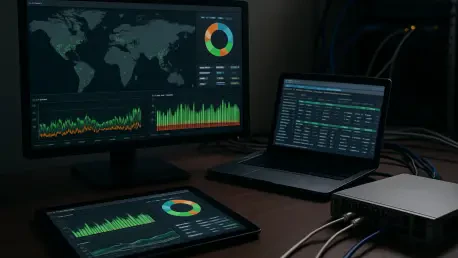In today’s rapidly evolving IT landscape, where hybrid cloud architectures and remote work environments have become standard, the role of network monitoring tools has never been more vital for businesses aiming to maintain seamless operations. As organizations depend on intricate, interconnected systems to drive productivity, ensuring network health and performance stands as a cornerstone of success. These tools deliver critical real-time insights, empowering IT teams to identify and address potential issues before they escalate into disruptive outages that can cost time and resources. With digital transformation accelerating, the ability to monitor routers, switches, servers, and applications effectively is no longer a luxury but a necessity for companies of all sizes.
This exploration delves into the leading network monitoring solutions that are shaping the industry in the current year, and with technology advancing at a breakneck pace, these tools have adapted to meet the demands of modern infrastructures, from vast enterprise networks to agile cloud-based setups. The integration of cutting-edge innovations like artificial intelligence (AI) and machine learning (ML) has shifted the paradigm from reactive troubleshooting to predictive prevention, setting a new standard for what businesses expect. By examining the standout players in this space, this discussion aims to highlight the features, scalability, and value propositions that distinguish the best options available today.
Core Features Defining Market Leaders
Instant Visibility Through Real-Time Monitoring
Real-time monitoring serves as the foundation for any effective network management tool in the current era, providing immediate visibility into performance bottlenecks and potential failures across an organization’s infrastructure. This capability ensures that IT teams can respond swiftly to anomalies, minimizing downtime and maintaining operational continuity. Tools like Datadog and SolarWinds Network Performance Monitor (NPM) exemplify this strength by offering dashboards that update instantaneously, reflecting the state of networks with precision. Beyond just tracking metrics, these solutions often include automated device discovery, which maps out connected hardware and software without requiring tedious manual input, saving valuable time for overstretched IT departments.
Another dimension of real-time monitoring lies in its ability to integrate with broader IT ecosystems, ensuring a comprehensive overview that spans on-premise and cloud environments. For instance, solutions such as Datadog not only monitor network performance but also correlate data with application health, giving teams a fuller picture of system interdependencies. This holistic approach is critical as businesses increasingly operate in hybrid setups where a single point of failure can ripple across multiple layers. By prioritizing instant visibility, these tools empower organizations to maintain high service levels, especially in industries where even minor disruptions can lead to significant financial or reputational damage.
Harnessing AI for Predictive Problem Solving
The incorporation of AI and automation into network monitoring marks a transformative leap, enabling IT teams to shift from merely reacting to issues to anticipating them before they occur. Tools like Dynatrace and LogicMonitor leverage sophisticated AI algorithms to analyze vast amounts of data, identifying patterns and anomalies that might indicate future problems. This predictive capability reduces the noise of constant alerts, allowing teams to focus on critical issues through automated root cause analysis. Such advancements are particularly valuable in dynamic environments where manual oversight struggles to keep pace with rapid changes.
Beyond prediction, AI-driven automation streamlines repetitive tasks, such as generating reports or adjusting thresholds, freeing up personnel for strategic initiatives. Dynatrace, with its Davis AI engine, exemplifies this by not only flagging irregularities but also suggesting actionable remedies, effectively acting as a virtual assistant for IT staff. LogicMonitor enhances this further with agentless monitoring, reducing setup complexity while maintaining deep insights. As networks grow in scale and sophistication, the reliance on such intelligent systems becomes indispensable, ensuring that businesses can maintain uptime and performance without expanding their workforce exponentially.
Scalability and Performance in Expanding Networks
Managing Vast and Distributed Infrastructures
As organizations grow, the ability of a network monitoring tool to scale with expanding infrastructures becomes a non-negotiable attribute, particularly for enterprises managing large, distributed systems across multiple locations. Tools like Zabbix and SolarWinds NPM are engineered to handle such demands, supporting thousands of devices and vast data volumes without compromising on speed or accuracy. This scalability ensures that as a company adds new branches, cloud services, or IoT endpoints, the monitoring solution remains robust, providing consistent visibility into every corner of the network, regardless of geographic spread or system diversity.
Equally important is the capacity to maintain performance under pressure, especially during peak usage or unexpected traffic spikes, which can challenge even the most robust systems. SolarWinds NPM, for example, offers features like NetPath, which provides hop-by-hop analysis to pinpoint bottlenecks even in sprawling setups. Zabbix complements this with customizable thresholds and alerts, ensuring that IT teams are not overwhelmed by irrelevant notifications as their networks expand. For global corporations or businesses planning rapid growth over the coming years, selecting a tool with proven scalability is essential to avoid the costly pitfalls of frequent system overhauls or performance lags that could disrupt critical operations.
Navigating the Maze of Modern Network Complexity
Modern networks often resemble a complex web of on-premise hardware, cloud-based services, and hybrid configurations, posing unique challenges for monitoring tools to provide seamless oversight across all components. Solutions like Checkmk rise to this challenge by offering adaptable frameworks that monitor diverse environments without sacrificing depth or detail. Whether it’s tracking legacy servers alongside cutting-edge cloud deployments, these tools ensure that no part of the infrastructure remains a blind spot, delivering unified insights that help IT teams manage the intricacies of today’s interconnected systems with confidence.
This adaptability also extends to handling the evolving nature of threats and performance demands that characterize contemporary IT landscapes. Checkmk, for instance, supports integration with various protocols and platforms, allowing for tailored monitoring that evolves alongside network changes. This flexibility is crucial for businesses undergoing digital transformation, where new technologies are adopted frequently, often outpacing traditional monitoring capabilities. By providing a solution that can keep up with such complexity, leading tools enable organizations to future-proof their operations, ensuring that as their systems become more intricate, their visibility and control remain uncompromised.
Usability and Deployment Flexibility
Simplifying Adoption with User-Friendly Designs
The ease with which a network monitoring tool can be adopted often determines its success within an organization, particularly for teams with limited technical expertise or constrained resources. Solutions like Paessler PRTG Network Monitor and Auvik stand out for their intuitive interfaces, which minimize the learning curve and allow IT staff to start monitoring effectively almost immediately after installation. PRTG, for instance, offers pre-configured sensors and drag-and-drop dashboards, making it accessible even to those unfamiliar with complex network management, thereby reducing the need for extensive training or external consultants.
Beyond initial setup, user-friendly design also impacts long-term usage, as it influences how efficiently teams can navigate daily tasks like generating reports or responding to alerts, making it a critical factor in operational success. Auvik enhances this with automated network mapping that visually represents infrastructure, simplifying troubleshooting for non-specialists. This focus on simplicity does not come at the expense of depth, as both tools provide detailed metrics and customization options for advanced users. For small to medium-sized businesses or overworked IT departments, prioritizing usability ensures that monitoring becomes a seamless part of operations rather than an additional burden requiring constant attention or specialized skills.
Catering to Diverse Deployment Preferences
Flexibility in deployment options is another critical factor shaping the appeal of network monitoring tools, as organizations have varied needs based on their infrastructure and security policies. Tools like SolarWinds NPM cater to those preferring on-premise setups, offering robust control over data and customization for complex, traditional networks. This approach suits industries with strict compliance requirements, where maintaining data within internal systems is paramount. By providing deep integration with existing hardware, such solutions ensure that businesses can monitor their environments without relinquishing oversight to external platforms.
On the other hand, cloud-based or SaaS models, exemplified by Datadog and Auvik, address the growing demand for rapid deployment and scalability, particularly among organizations leveraging cloud services extensively. These tools enable quick setup without the need for significant hardware investment, making them ideal for startups or businesses with distributed teams. Additionally, hybrid options allow for a balanced approach, combining the security of on-premise solutions with the agility of the cloud. This diversity in deployment models ensures that whether a company prioritizes control, speed, or a mix of both, there’s a monitoring solution tailored to fit seamlessly into its operational framework.
Balancing Cost and Long-Term Value
Weighing Affordability Against Functionality
Cost remains a pivotal consideration for many organizations when selecting a network monitoring tool, but the focus in the current market extends beyond mere price to encompass the functionality delivered for the investment. Open-source options like Nagios Core provide a budget-friendly entry point with no licensing fees, appealing to smaller firms or those with in-house technical expertise willing to invest time in setup and customization. However, the hidden costs of maintenance and the steep learning curve can offset initial savings, particularly for teams lacking the resources to manage complex configurations independently.
In contrast, premium solutions like Dynatrace, while carrying a higher upfront cost, bundle comprehensive features, automated processes, and dedicated support into their pricing models. This can prove more economical for larger enterprises or those in high-stakes industries where downtime equates to substantial losses. The key lies in assessing whether the tool’s capabilities align with organizational needs—spending more on a solution that reduces manual effort and enhances reliability often outweighs the allure of a free or low-cost alternative that demands ongoing intervention. This balance of affordability and functionality drives decision-making in today’s competitive landscape.
Maximizing Returns Through Operational Efficiency
Investing in a higher-priced network monitoring tool can yield significant long-term savings by enhancing operational efficiency and reducing the incidence of costly disruptions. Tools like Datadog exemplify this principle by automating routine tasks and providing AI-driven insights that minimize the time spent on troubleshooting. For businesses operating in environments where every minute of downtime translates to lost revenue, such capabilities can justify the initial expenditure, as they directly contribute to maintaining service continuity and customer satisfaction over extended periods.
Moreover, efficiency gains extend beyond immediate problem resolution to include strategic benefits like improved resource allocation and better planning for future growth. Datadog’s ability to integrate with cloud platforms and provide full-stack observability means IT teams spend less time piecing together disparate data sources and more time on innovation or optimization projects. This shift in focus from reactive to proactive management can transform a monitoring tool from a cost center into a value driver. For organizations evaluating their options, considering the broader impact on productivity and system reliability often reveals that true savings lie in the enhanced performance a premium tool can deliver.
Tailored Solutions for Varied Needs
Meeting Specific Organizational Demands
Network monitoring tools are not a one-size-fits-all proposition, as different organizations face unique challenges based on their structure, goals, and operational scope. Solutions like Auvik are specifically designed for Managed Service Providers (MSPs) who oversee multiple client sites, offering features such as automated mapping and configuration backups that simplify multi-tenant management. This specialization ensures that MSPs can deliver consistent service across diverse networks without being bogged down by manual processes, enhancing their ability to scale services and maintain client trust in a competitive market.
Conversely, tools like Datadog cater to DevOps teams with a need for full-stack observability, linking network performance with application health and user experience metrics. This integrated approach is invaluable for organizations prioritizing agile development and continuous deployment, where understanding the interplay between different system layers can accelerate issue resolution and improve software delivery. By aligning their feature sets with specific use cases, these tools demonstrate how targeted design can address niche pain points, ensuring that whether a business focuses on service provision or software innovation, there’s a monitoring solution built to support its distinct workflow.
Adapting to Industry and Regional Differences
The preferences for network monitoring tools often vary depending on industry demands and geographic considerations, reflecting the diverse priorities that shape technology adoption across sectors. In technology-driven fields like finance or e-commerce, where uptime and data security are paramount, there’s a clear tilt toward advanced solutions with robust AI capabilities and comprehensive reporting, such as Dynatrace or LogicMonitor. These tools provide the depth needed to monitor complex, high-stakes environments, ensuring that even minor performance hiccups are caught and addressed before they impact critical transactions or customer trust.
Meanwhile, small businesses or those in regions with limited budgets often gravitate toward solutions that prioritize simplicity and cost-effectiveness, such as ManageEngine OpManager. This tool offers a balanced mix of essential monitoring features and an accessible interface, making it suitable for organizations without dedicated IT specialists or large financial reserves. These variations highlight the importance of contextual fit—geographic constraints like bandwidth availability or local regulations can further influence whether a cloud-based or on-premise tool is preferred. By offering a spectrum of options, the market ensures that from global enterprises to local startups, every entity can find a monitoring solution aligned with its operational and cultural realities.
Emerging Trends Shaping the Monitoring Landscape
Dominance of Cloud-Native and Hybrid Environments
The shift toward cloud-native and hybrid IT environments has profoundly influenced network monitoring priorities, with businesses increasingly moving away from traditional on-premise setups to embrace distributed architectures. Tools like Datadog, LogicMonitor, and Auvik are at the forefront of this transition, providing seamless integration with major cloud platforms and robust support for multi-cloud strategies. This capability is crucial as organizations leverage services from multiple providers to optimize cost and performance, requiring monitoring solutions that can track resources across diverse ecosystems without creating visibility gaps or data silos.
This trend also reflects a broader push for agility and scalability, as cloud-native tools enable rapid adaptation to changing workloads or sudden demand spikes. Auvik, for instance, simplifies oversight of distributed networks through its SaaS model, allowing IT teams to monitor remote sites or cloud assets from a centralized platform. LogicMonitor enhances this with agentless deployment, reducing setup overhead while maintaining deep insights into hybrid setups. As more companies adopt these flexible architectures, the ability of monitoring tools to bridge on-premise and cloud environments becomes a defining factor, ensuring that businesses can maintain control and performance regardless of where their data resides.
The Rise of Unified Observability Platforms
Beyond traditional network monitoring, there’s a growing demand for unified observability platforms that provide a holistic view of IT ecosystems, encompassing networks, applications, and end-user experiences. Solutions like Datadog and Dynatrace lead this charge by correlating data across multiple layers, enabling IT teams to understand how network performance impacts software functionality or customer interactions. This comprehensive approach is increasingly valued over standalone tools, as it offers deeper insights into system interdependencies, helping pinpoint the root causes of issues that span beyond mere connectivity or hardware metrics.
The push for observability also aligns with the complexities of modern service delivery, where user satisfaction hinges on seamless integration across all touchpoints, making it a critical focus for businesses. Dynatrace’s AI-driven analytics, for instance, not only monitor network health but also trace application performance down to individual user transactions, providing actionable intelligence for optimization. Datadog complements this by offering customizable dashboards that unify disparate data streams into a single pane of glass. For businesses aiming to deliver exceptional digital experiences, adopting such platforms is becoming essential, as they transform fragmented monitoring into a cohesive strategy that prioritizes both technical stability and user-centric outcomes.
Reflecting on Strategic Choices for Network Oversight
Looking back, the journey through the landscape of network monitoring tools revealed a market rich with innovation and diversity, where solutions like Datadog, SolarWinds NPM, and Dynatrace have carved out distinct niches by addressing specific pain points with precision. The emphasis on real-time visibility, AI-driven automation, and scalability underscores how far the industry has come in meeting the challenges of intricate IT environments. Each tool, from Zabbix’s open-source flexibility to Auvik’s MSP-focused design, has played a role in shaping a field that prioritizes adaptability and performance, reflecting the varied needs of businesses navigating digital transformation.
Moving forward, organizations should focus on aligning their monitoring strategies with long-term goals, considering not just immediate needs but also future growth and technological shifts. Evaluating tools based on scalability, deployment fit, and the balance of cost versus efficiency will be crucial steps in this process. Additionally, embracing trends like unified observability and cloud integration can position companies to stay ahead of potential disruptions. By investing in solutions that offer predictive insights and tailored functionalities, businesses can build resilient networks that support sustained success, ensuring they remain agile in an ever-evolving digital world.









